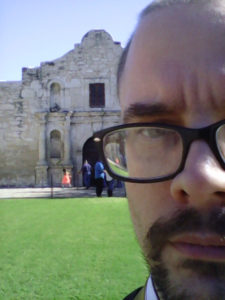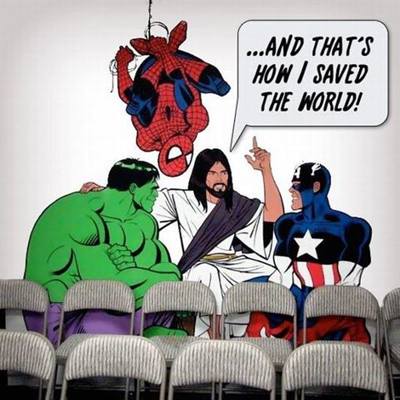 [The following entry is written by John Fadden, PhD., an adjunct lecturer across Western New York and frequent contributor to the Society of Biblical Literature. It is presented here with his permission.]
[The following entry is written by John Fadden, PhD., an adjunct lecturer across Western New York and frequent contributor to the Society of Biblical Literature. It is presented here with his permission.]
I teach an undergraduate introduction to the New Testament course that is mostly filled with students taking the course to fulfill requirements of the college’s core curriculum. I assume most students do not have a background in the cultural contexts of the writers of the New Testament, nor that most students have any connection to, or have read the New Testament. Yet, I also expect that because the New Testament is the “Bible,” students, including non-Christians, have certain expectations about the Gospels as historical documents that provide accurate portrayals of Jesus’s life. Most of the students have never thought about the literary practices in the cultural context that would have influenced the gospel writers.
In the spring semester, I added a new activity to the course in hopes of pushing students to think about the Gospels as imitating the classical epics by introducing them to Dennis MacDonald’s mimetic theory. While a lot of MacDonald’s scholarship is beyond the undergraduate non-major reading level, his Mythologizing Jesus: From Jewish Teacher to Epic Hero (Rowman & Littlefield, 2005) provides a popular audience access to his scholarship. Since I assumed that my students have a limited background in the classics (and no knowledge of Greek), I wanted to come up with a way to have them engage with MacDonald’s ideas, but using stories familiar to their own cultural settings from the superhero genre. The initial goal was for students to imitate a superhero scene to create a pericope about Jesus. To add a degree of difficulty (and to fit within the course’s core curriculum requirements) students also had to make it fit into the first century context (so no saving an airplane from crashing). The course also has a public speaking / presentation requirement, so the student’s final creation was delivered in front of their classmates.
 The activity required multiple engagements with the topic. First, I assigned the students read parts of MacDonald’s book to introduce them to his theory. I also asked students to pick a superhero story from a movie, TV show, or comic book that they could write in a 10-15 verse story (suggesting students think about MacDonald’s work as they chose it). In the next class session, we discussed the reading from MacDonald. I demonstrated how they might imitate their contemporary superhero story when writing a story about Jesus using the concluding scene from Jessica Jones season 1, episode 12 as an example. (I figured it was old enough I wouldn’t be guilty of spoilers, but I discovered few students had watched it; so I might recommend adding a few minutes into the class to show a clip of whatever story you are imitating in your demonstration.) I also showed them how the imitator might leave clues for her audience to be able to recognize the source story (for example, playing with a notable name like Kilgrave could signal to those familiar with Jessica Jones that there was a connection). I gave the students a week to write their imitation of a superhero story as a pericope about Jesus.
The activity required multiple engagements with the topic. First, I assigned the students read parts of MacDonald’s book to introduce them to his theory. I also asked students to pick a superhero story from a movie, TV show, or comic book that they could write in a 10-15 verse story (suggesting students think about MacDonald’s work as they chose it). In the next class session, we discussed the reading from MacDonald. I demonstrated how they might imitate their contemporary superhero story when writing a story about Jesus using the concluding scene from Jessica Jones season 1, episode 12 as an example. (I figured it was old enough I wouldn’t be guilty of spoilers, but I discovered few students had watched it; so I might recommend adding a few minutes into the class to show a clip of whatever story you are imitating in your demonstration.) I also showed them how the imitator might leave clues for her audience to be able to recognize the source story (for example, playing with a notable name like Kilgrave could signal to those familiar with Jessica Jones that there was a connection). I gave the students a week to write their imitation of a superhero story as a pericope about Jesus.
Students read their pericopes in front of their classmates. Then their classmates indicated whether they observed the superhero connection. I (and a few brave classmates) asked follow up questions about their choices in relation to their source story as well as how they depicted Jesus and other characters. The assignment allowed students to think about in what sense Jesus was a better superhero in their imitation, so students showed an awareness of authorial choices about their characters. Some of the students noted their personal theological understandings influenced their choices. Others stated they liked the source material and were not as concerned with making the christological claims I heard in their story. I also asked about the activities Jesus imitated in the pericopes. Many students transformed superhero activities into Jesus performing miracles. But a few students chose episodes from superhero stories that allowed for other aspects of Jesus’s character to be shown superior to other superheroes. The responses and discussion indicated that the students had developed a more complex notion of what the gospel writers may have been doing than the students previously had.
So what superheroes were chosen? One student wanted to emphasize in his Jesus characteristics he saw in Charles Xavier (as a teacher and telepath) who had his own group (but no explicit which disciple is which X-Men member). Another student wanted to emphasize Jesus’s ability to comfort those who are mourning and this image found its way into a Wonder Woman account. Spider-Man, Superman, Thor, Batman, the Hulk, and Aquaman had abilities that students imitated as miracle stories. Finally, one student perhaps pushed the boundaries of ‘superhero’ so that he might imitate part of Star Wars: A New Hope with Luke Skywalker as the hero.
Since I ws interested in helping students to think about the ancient gospel writers, I also asked about possible anachronisms and geographical errors in the students stories, or how they avoided them. Some of the anachronisms were things we had not discussed yet in the semester, so it was not like they would know they put an anachronism in their story. Rather, it helped to show students how easy it can be for writers even of the same time period but from a different location and background to put inaccurate materials into their stories because it maybe fit the narrative they were imitating regardless of its appropriateness to the setting. So, a bonus of the activity was getting to discuss the ancient context and its things (such as different types of houses) that students may not have thought were relevant before they tried to write their pericope.
As a first time experiment, the majority of the results were okay to really creative. Some students misunderstood the assignment, so I need to refine the initial demonstration to lessen any confusion. I was surprised by the number of students (men and women) who had not watched a superhero movie or TV show or read a superhero comic book. So, I might narrow the choices in future iterations of the assignment. Perhaps, as a class, we might take and entire superhero cycle (multiple films or a full TV season) to create a class gospel with each student writing a pericope imitating one of the scenes.
 One thing I noticed was in a class with a mix of ethnicities and about equal numbers of men and women, the superheroes chosen were not very diverse. I’m not sure if this is due to the small sample-size of the class, but it is something I am thinking about for next time. Even though Black Panther was the movie this spring, no one used that story plot. Last year’s summer hit Wonder Woman provided one plot, but Jesus was not imitating Diana in the student’s account. I wonder if it might be beneficial to suggest explicitly that students should choose their superhero not based on the superhero’s ability to pass as a White guy but on the qualities and characteristics the students wish to convey as important for their superhero.
One thing I noticed was in a class with a mix of ethnicities and about equal numbers of men and women, the superheroes chosen were not very diverse. I’m not sure if this is due to the small sample-size of the class, but it is something I am thinking about for next time. Even though Black Panther was the movie this spring, no one used that story plot. Last year’s summer hit Wonder Woman provided one plot, but Jesus was not imitating Diana in the student’s account. I wonder if it might be beneficial to suggest explicitly that students should choose their superhero not based on the superhero’s ability to pass as a White guy but on the qualities and characteristics the students wish to convey as important for their superhero.
Finally, the activity left an impression on the students. I could talk to students about the narratives without them jumping to “this is a historical account” once they had tried writing stories about Jesus imitating superheroes. They could appreciate that maybe the gospel writers were trying to imitate the classics and one up the superhero stories of their day.
Feel free to use the activity and improve it with your own twists.
Supplement
Here are my after-trying-it-once prompts for next time. (I don’t use a rubric for the activity because it is really low stakes and I want students to have the ability to try without the anxiety of trying to do exactly what the professor is expecting beyond what is in the prompts.)
Day 1 Prompt for Reading: Read Introduction and Conclusion of MacDonald. Be prepared to talk about his basic argument, his criteria for imitation, and how his example works to illustrate his argument and the criteria. What questions do you have about what you read? How does his gospel writers “mythologizing” Jesus compare to your previous understanding of the gospel writers?
Day 2 Prompt for Selecting: Choose a superhero who has characteristics and qualities that make them a possible source for imitation when you write Jesus as a better superhero. What story or scene from your superhero’s canon might you imitate to show off these qualities?
Note 1: If you aren’t familiar with superheroes, determine the qualities you want to highlight and your classmates may be able to help you find an appropriate hero.
Note 2: It is okay to choose superheroes that don’t look like whatever you think Jesus looked like (whether gender, ethnicity, species).
(FYI: adding the selection as a second day activity should allow for sufficient time to cover MacDonald on Day 1 and start students thinking about their potential selections. On Day 2, then, I can offer the demonstration and have students who are having problems selecting a hero get help from classmates.)
Prompt for Imitating: Now that you have selected your source superhero, try to imitate your selected story or scene with Jesus as your better superhero. You may need to re-read or re-watch the scene to find elements for your story. The story should only be 10-15 verses long, no more than 20. You will submit a paper copy of your story on Presentation Day. Please include a citation of your source material at the bottom of the paper.
Keep in mind MacDonald’s argument and criteria as you try to imitate the source material.
Remember, in your story, Jesus is still in first century Galilee or Judea, so remember / apply what you have learned about the cultural context to keep your story appropriate to the first century.
You will be presenting your story in front of the class. We will try to guess what superhero account you are imitating and what qualities are important. We also get to ask you questions. So practice reading it out loud before you come to class.
Presentation Day is [insert date].
Activity Reflection Prompt: Write one paragraph on MacDonald’s theory and your attempt to write a gospel account by imitating a twenty-first century superhero. Credit is given for a thoughtful and critical reflection, not writing what you think I want to hear or to get something submitted before it is due.
